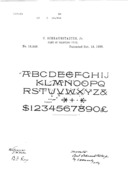Designed and cut by Gustave F. Schroeder while at Central Type Foundry [1] [2]
Saxe, in his edition of Loy, shows it and cites the patent date, 19 Oct. 1886 (US design patent 16,946, issued to Carl Schraubstadter, Jr.) Shown in the Saxe/Johnston edition of Loy, p. 74.
Mullen (p. 138) [2] offers further details. He dates it to 1885, as "the first type advertised by Central in The Inland Printer in December 1885." (Vol. 3, No. 3 (Dec., 1885): 161. See below.) He cites US design patent 16,946 Oct. 19, 1886 for it (this matches the list in the Saxe/Johnston edition of Loy) and says that this is the "same patent as that for Victoria." (There is no listing in Saxe/Johnston/Loy of a patent for Victoria; Atlanta and Victoria do indeed resemble each other.) Mullen also says that its design was "suggested by A. V. Haight." Haight, of Poughkeepsie, NY, was a compositor and printer recorded in the pages of The Inland Printer as having won several design prizes.
Mullen also cites this as an early lining face. (Lining was a particular concern of Nicholas J. Werner at Central and later.) In their 1885 showing, Central (possibly Werner himself, as he composed their specimens) explains it thus:
"The different sizes of the Atlanta series are cut and cast to line with each other at the top, the bottom, and the centre of the face. Neither cardboard nor paper required in combining the series as caps and small caps. Use leads and slugs."
This is an example of the concept of a "lining" face - where the various sizes work together within the face spaced vertically using only standard leads or slugs. This concept is slightly different from that of a lining system between typefaces - where multiple typefaces from the same foundry are cast to line together.
As is typical (but not universal) with lining faces, there is no lowercase.
Atlanta is distinguished among lining faces because it was designed (and, at least by Central, cut and cast) to line not only at the bottom but also at the top and centered vertically. This is a much greater display of type making skill than one might at first think.
Scanned by DMM from the original. Public domain. The image above links to a 2048 pixel wide JPEG reduction of the original scan, which is a useful size. For reference, here is the original 600dpi PNG scan of the entire page (4360x6498 pixels, 14 Megabytes): inland-printer-v03n03-1885-12-uw-0600grey-161-type-specimen-central-type-foundry.png

US Design Patent 16,946 (1885)
US design patent 16,946, "Design for a Font of Printing-Type." Issued 1886-10-19 to Carl Schraubstadter, Jr. Filed 1886-02-10 as application serial no. 191,519.
Atlanta was offered by ATF for several years after the amalgamation of Central into ATF. It is shown in the 1900 ATF Desk Book of Type Specimens , but not in the 1906 American Line Type Book . It was not assigned an ATF series number (these were assigned beginning about 1930). There is no mention of its lining characteristics (if there were any) in the 1900 ATF specimens from at least 1897 on.
(From: Specimens of Printing Types. (New York: American Type Founders Company, 1897.) Scanned by Microsoft Corp. from a University of California copy and available via The Interet Archive at http://www.archive.org/details/specimensofprint00amerrich.)
(The image above links to a 2048 pixel wide JPEG version of this page, which is quite suitable for ordinary viewing. The original scan was distributed in JPEG2000 (".jp2") format, is not in ordinary viewing orientation, and shows the scanning apparatus in the background. Here's a version of it rendered into PNG (but still at full available resolution), rotated, and cropped to the page dimensions: atf-1897-specimens-of-printing-types-archive-org-specimensofprint00amerrich_raw_0364-atlanta-rot90ccw-crop-2381x3707.png Here's the original scan, as distributed by The Internet Archive: atf-1897-specimens-of-printing-types-archive-org-specimensofprint00amerrich_raw_0364-atlanta.jp2)
There is no mention at all of the lining characteristics, if any, of this type as cast by ATF. (The fact that they cast it from ex-Central matrices by no means implies that they cast it as a lining face.)
1. Werner, N. J. An Address by N. J. Werner of St. Louis. St. Louis: [St. Louis Club of Printing House Craftsmen, 1931. , reprinted as "St. Louis in Type-Founding History" Share Your Knowledge Review, Vol. 22, No. 3 (January 1941): 21-26.
2. Loy, William E. "Designers and Engravers of Type," No. 11 - Gustav F. Schroeder. The Inland Printer. Vol. 22, No. 3 (1898-12), p. 338.
3. Mullen, Robert A. Recasting a Craft: St. Louis Typefounders Respond to Industrialization. (Carbondale, IL: Southern Illinois Univ. Press, 2005).
All of the type specimen documents reproduced or extracted from here are in the public domain due to their publication without copyright notice when such notice was required, or the failure to renew copyright as was then required, or the expiration of all possible copyright. The reproductions of/from them here remain in the public domain.
All portions of this document not noted otherwise are Copyright © 2009-2011 by David M. MacMillan and Rollande Krandall.
Circuitous Root is a Registered Trademark of David M. MacMillan and Rollande Krandall.
This work is licensed under the Creative Commons "Attribution - ShareAlike" license. See http://creativecommons.org/licenses/by-sa/3.0/ for its terms.
Presented originally by Circuitous Root®
Select Resolution: 0 [other resolutions temporarily disabled due to lack of disk space]